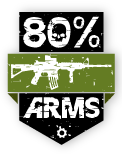VanDerStok Explained: What the Ruling Does and Doesn’t Do
On March 26, 2025, the Supreme Court released its opinion in Bondi v. VanDerStok. The decision reversed the Fifth Circuit and ruled that the ATF's 2022 “frame or receiver” rule is not facially invalid under the Gun Control Act. That means the rule stays for now, but it’s not the end of the road. We are not lawyers, this is our best early interpretation of their ruling.
Based on our reading, the Supreme Court’s decision in VanDerStok v. Garland does not outlaw 80% AR lowers.
The ruling specifically addressed the ATF’s authority to regulate certain weapon parts kits and partially complete frames or receivers, primarily focusing on pistol build kits, like Polymer80’s “Buy Build Shoot” kits, which include everything needed to quickly assemble a working handgun.
This decision does not automatically ban 80% AR lowers when sold on their own without jigs.
The fight is ongoing, and there’s still room to challenge how the ATF applies this rule to specific products but to be clear:
-
AR lowers are not banned.
-
This ruling does not apply to all 80% products.
-
It primarily impacts 80% pistol frames bundled in kits.
-
76% frames are still available on our website.
Here’s what you need to know.
The ATF Rule Survives—On Its Face
The Court ruled that some weapon parts kits and unfinished frames or receivers can be treated as “firearms” under federal law if they’re “designed to or may readily be converted” into operable guns.
As the Court put it:
“Because at least some weapon parts kits satisfy both of subsection (A)’s tests, §478.11 is not facially invalid.” (Slip op., p. 17)
Same goes for unfinished frames or receivers:
“The GCA reaches, and permits ATF to regulate, at least some ‘partially complete’ frames or receivers.” (p. 17)
This ruling doesn’t mean the fight is over. It just means the ATF’s rule isn’t invalid on its face. The Court left the door wide open for as-applied challenges against the rule, something we’ve been saying since day one.
“Future cases may present other and more difficult questions about ATF’s regulations. But we take cases as they come and today resolve only the question posed to us.” (p. 13)
In plain English? The Court said, yes, the rule can apply to some kits but not necessarily all.
The Court Used One Specific Kit as Their Example
The decision leans heavily on Polymer80’s “Buy Build Shoot” kit, which included everything needed to assemble a pistol in ~20 minutes using common tools.
“That kit qualifies as a ‘weapon’ because… the intended function as an instrument of combat is obvious. Really, the kit’s name says it all: ‘Buy Build Shoot.’” (p. 11)
They even included photos in the opinion.
So what does that mean? The ruling focused on one specific type of full kit—not standalone 80% lowers sold without additional components.
Not Everything Can Be Regulated
Even the Supreme Court admitted there are limits.
“Some products may be so far from a finished frame or receiver that they cannot fairly be described using those terms.” (p. 21)
And on the “weapon” definition:
“Some kits may require more time, expertise, or specialized tools to finish. And at some point a kit may be so incomplete... that it can no longer fairly be described as a ‘weapon.’” (p. 13)
Translation: Not every unfinished lower is a firearm. Period.
ATF’s Power Isn’t Unlimited
The Court explicitly rejected the idea that ATF can regulate everything. In fact, they stated:
“The statute’s text and context are critical... And, without doubt, the NFA and the GCA are different statutes passed at different times to address different problems using different language.” (p. 23)
So if ATF tries to push this rule further? We’ll be ready.
What Happens Now?
The case goes back to the lower courts. Our team and others in this fight will continue challenging how the rule is applied to specific products, especially standalone 80% lowers. We’ve been here since day one, and we’re not backing down now.
“The plaintiffs do not challenge ATF’s new rule as applied to particular products. They argue only that §478.12 is facially inconsistent with the GCA. And, here again, we have no trouble rejecting that unqualified view.” (p. 21)
We heard that loud and clear. Challenge accepted.
Final Thoughts
The Supreme Court didn’t kill the ATF rule, but they didn’t bless it entirely either. They upheld it only as it applies to certain kits and admitted that many unfinished products may still fall outside its reach.
This isn’t over. In fact, the real fight starts now. While the Supreme Court’s decision keeps the ATF’s rule in place, it also left the door wide open for continued legal challenges and that’s exactly what we’re doing. You can support our ongoing battle by continuing to shop with us. Every order helps fund our legal efforts to reinstate your ability to purchase 80% GST-9 frames and jigs directly from us, just like before. In the meantime, 76% bridge frames and 80% lowers are still available on our website.
We're not backing down, and with your support, we're pushing forward harder than ever.



 Back to List
Back to List